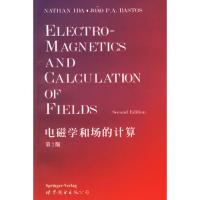| 定价: | ¥ 89 | ||
| 作者: | N.Ida,J.P.A.Bastos 编著 | ||
| 出版: | 世界图书出版公司 | ||
| 书号: | 9787506214636 | ||
| 语言: | 英文原版 | ||
| 日期: | 1999-11-01 | ||
| 版次: | 1 | 页数: | 565 |
| 开本: | 16开 | 查看: | 0次 |

| 服务商城 | 客服电话 | 配送服务 | 优惠价 | 购买 |
| 400-711-6699 | 满29至69元,免运费! | ¥66.8 |
This second edition of Electromagnetics and Calculation of Fields was undertaken with the intention of both updating the first edition and, most importantly, introducing the new subject of edge or vector finite elements. We felt that edge elements have matured enough to be included in a text of this type. In addition, the original text was expanded to include an introduction to the finite element method as a general design tool with in-depth discussion of the method's practical aspects, before its application to specific electromagnetic phenomena is introduced. Many of the features of the previous edition as well as the general appearance and flavor were retained while the coverage was extended and the presentation improved. ...
Preface
PartⅠ.The Electromagnetic Field and Maxwell's Equations
1. Mathematical Preliminaries
1.1. Introduction
1.2. The Vector Notation
1.3. Vector Derivation
1.3.1. The Nabla (V) Operator
1.3.2. DefinitionoftheGradient, Div rgence, and Curl
1.4. TheGradient
1.4.1. Example of Gradient
1.5. The Divergence
1.5.1. Defmition of Flux
1.5.2. The Divergence Theorem
1.5.3. Conservative Flux
1.5.4. Example of Divergence
1.6. TheCurl
1.6.1. Circulation of a Vector
1.6.2. Stokes'Theorem
1.6.3. Example of Curl
1.7. Second Order Operators
1.8. Application of Operators to More than One Function
1.9. Expressions in Cylindrical and Spherical Coordinates
2. The Electromagnetic Field and Maxwell's Equations
2.1. Introduction
2.2. Maxwell's Equations
2.2.1. Fundamental Physical Principles ofthe Electromagnetic Pield
2.2.2. Point Form of the Equations
2.2.3. The Equations in Vacuum
2.2.4. The Equations in Media with and
2.2.5. The Equations in General Media
2.2.6. The Integral Form ofMaxwell's Equations
2.3. Approximations to Maxwell's Equations
2.4. Units
3 Electrostatic Fields
3.1. Introduction
3.2. The Electrostatic Charge
3.2.1. The Electric Field
3.2.2. Force on an Electric Charge
3.2.3. The Electric Scalar Potential V
3.3. Nonconservative Fields: Electromotive Force
3.4. RefractionoftheElectricField
3.5. Dielectric Strength
3.6. The Capacitor
3.6.1. Defmition of Capacitance
3.6.2. Energy Stored in a Capacitor
3.6.3. Energy in a Static, Conservative Fie 1
3.7. Laplace's and Poisson's Equations in Tem of the Electric Field
3.8. Examples
3.8.1. The Infmite Charged Line
3.8.2. The Charged Spherical Half-Shell
3.8.3. The Spherical Capacitor
3.8.4. The Spherical Capacitor with Two Dielectric Layers
3.9. A Brief Introduction to the Finite Element Method: Solution of the Two-Dimensional Laplace Equation
3.9.1. The Finite Element Technique for Division of a Domain
3.9.2. The Variational Method
3.9.3. A Finite Element Program
3.9.4. Example for Use of the Finite Element Program
3.10. Tables of Permittivities, Dielectric Strength, and Conductivities
4. Magnetostatic Fields
4.1. Introduction
4.2. Maxwell's Equations in Magnetostatics
4.2.1. The Equation
4.2.2. The Equation
4.2.3. The Equation
……
5. Magnetodynamic Fields
6. Interaction between Electromagnetic and Mechanical Forces
7. Wave Propagation and High-Frequency Electromagnetic Fields
PartⅡ.Introduction to the Finite Element Method in Electromagnetics
8. Introduction to the Finite Element Method
9. The Variational Finite Element Method:Some Static Applications
10. Galerkin's Residual Method: Applications to Dynamic Fields
11. Hexahedral Edge Elements - Some 3D Applications
12. Computational Aspects in Finite Element
13. General Organization of Field Computation Software
Bibliography
Subject Index
PartⅠ.The Electromagnetic Field and Maxwell's Equations
1. Mathematical Preliminaries
1.1. Introduction
1.2. The Vector Notation
1.3. Vector Derivation
1.3.1. The Nabla (V) Operator
1.3.2. DefinitionoftheGradient, Div rgence, and Curl
1.4. TheGradient
1.4.1. Example of Gradient
1.5. The Divergence
1.5.1. Defmition of Flux
1.5.2. The Divergence Theorem
1.5.3. Conservative Flux
1.5.4. Example of Divergence
1.6. TheCurl
1.6.1. Circulation of a Vector
1.6.2. Stokes'Theorem
1.6.3. Example of Curl
1.7. Second Order Operators
1.8. Application of Operators to More than One Function
1.9. Expressions in Cylindrical and Spherical Coordinates
2. The Electromagnetic Field and Maxwell's Equations
2.1. Introduction
2.2. Maxwell's Equations
2.2.1. Fundamental Physical Principles ofthe Electromagnetic Pield
2.2.2. Point Form of the Equations
2.2.3. The Equations in Vacuum
2.2.4. The Equations in Media with and
2.2.5. The Equations in General Media
2.2.6. The Integral Form ofMaxwell's Equations
2.3. Approximations to Maxwell's Equations
2.4. Units
3 Electrostatic Fields
3.1. Introduction
3.2. The Electrostatic Charge
3.2.1. The Electric Field
3.2.2. Force on an Electric Charge
3.2.3. The Electric Scalar Potential V
3.3. Nonconservative Fields: Electromotive Force
3.4. RefractionoftheElectricField
3.5. Dielectric Strength
3.6. The Capacitor
3.6.1. Defmition of Capacitance
3.6.2. Energy Stored in a Capacitor
3.6.3. Energy in a Static, Conservative Fie 1
3.7. Laplace's and Poisson's Equations in Tem of the Electric Field
3.8. Examples
3.8.1. The Infmite Charged Line
3.8.2. The Charged Spherical Half-Shell
3.8.3. The Spherical Capacitor
3.8.4. The Spherical Capacitor with Two Dielectric Layers
3.9. A Brief Introduction to the Finite Element Method: Solution of the Two-Dimensional Laplace Equation
3.9.1. The Finite Element Technique for Division of a Domain
3.9.2. The Variational Method
3.9.3. A Finite Element Program
3.9.4. Example for Use of the Finite Element Program
3.10. Tables of Permittivities, Dielectric Strength, and Conductivities
4. Magnetostatic Fields
4.1. Introduction
4.2. Maxwell's Equations in Magnetostatics
4.2.1. The Equation
4.2.2. The Equation
4.2.3. The Equation
……
5. Magnetodynamic Fields
6. Interaction between Electromagnetic and Mechanical Forces
7. Wave Propagation and High-Frequency Electromagnetic Fields
PartⅡ.Introduction to the Finite Element Method in Electromagnetics
8. Introduction to the Finite Element Method
9. The Variational Finite Element Method:Some Static Applications
10. Galerkin's Residual Method: Applications to Dynamic Fields
11. Hexahedral Edge Elements - Some 3D Applications
12. Computational Aspects in Finite Element
13. General Organization of Field Computation Software
Bibliography
Subject Index





 粤公网安备 44030902003195号
粤公网安备 44030902003195号